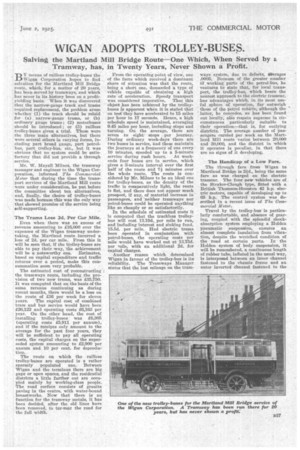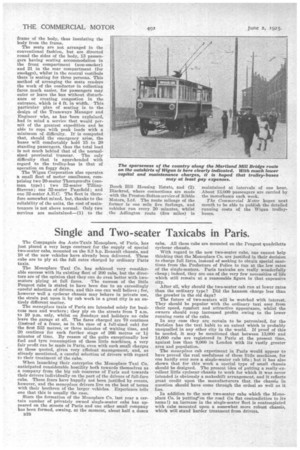WIGAN ADOPTS TROLLEY-BUSE S ,
Page 11

Page 12

If you've noticed an error in this article please click here to report it so we can fix it.
Salving the Martland Mill Bridge Route—One Which, When Served by g Tramway, has, in Twenty Years, Never Shown a Profit.
• "Do Y means of railless trolley-buses the LID Wigan Corporation hopes to find salvation for the Martian(' Mill Bridge route, which, for a matter of 20 years, has been served by tramways, and which has never in its history been on a profityielding basis. When it was discovered that the narrow-gauge track and trams required replacement, the problem arose whether (1) the track should be relaid for (a) narrow-gauge trams, or (b) ordinary gauge trams; (2) motorbu.ses should be introduced; or (3) railless trolley-buses given a trial. These were
• the three main alternatives, but there were several others in varying forms, including part broad gauge, part petrolbus, part trolley-bus, etc., but it was obvious that no system could be satislaetory that did not provide a through service.
Mr. W. Mayali Milnes, the tramway manager and engineer to the Wigan Corporation, informed The Commercia2 Moor that during the time the transport services of the Martland Mill route were under consideration, he put before the committee about ten alternatives, and, finally, the choice of trolley-buses was made because this was the only way that showed promise of the service being self-supporting.
The Trams Lose 2d. Per Car Mile,
Even when there was an excess of revenue amounting to £16,000 over the expenses of the Wigan tramway undertaking, the ileiartiand route incurred a loss of 2d per car mile. From this it will be seen that, if the trolley-buses are able to pay their way, the achievement will be a noteworthy one. Estimates, based on capital expenditure and traffic returns over a period, make this consummation seem very probable.
The estimated cost of reconstructing the tramways route, including the provision of two new trams, was £35,750. It was computed that on the basis of the same revenue continuing as during recent months, there would be a loss on the route of 136 per week for eleven
years. The capital cost of combined tram and bus service would have been £26,122 and operating eosts £6,163 per year. On the other hand, the cost of installing trolley-buses was £8,305 (operating costs £5,911 per annum), and if the receipts only amount to the average for the past four years, they will be sufficient to pay all operating costs, the capital charges on the superseded system amounting to 12,900 per annum and 10 per cent, for depreciation.
The route on which the Tailless trolley-buses are operated is a rather sparsely populated one. Between Wigan and the terminus there are big gaps or open spaces, and the residential districts a little further out are occupied mainly by working-class people. The road surface consists of granite paving in the centre, with water-bound breastwork. Now that there is no function for the tramway metals, it has been decided, after the old lines have been removed, to tar-mac the road for the full width.
From the operating point of view, one of the facts which received a dominant share of attention was that the route, being a short one, demanded a type of vehicle capable of obtaining a high rate of acceleration. Speedy transport was considered imperative. That this object has been achieved by the trolleybuses is apparent when it is stated that on test they have accelerated to 15 miles per hour in 17 seconds. Hence, a high schedule speed is maintained, averaging 9.45 miles per hour, including stops and turning. On the average, there are seven to eight stops per journey. During ordinary week-days there are two buses in service, and these maintain the journeys at a frequency of one every 10 minutes, speeded up to a 5-minute service during rush hours. At weekends four buses are in service, which gives a 3-minute interval over the first half of the route and 74• minutes over the whole route. The route is considered by Mr. Mines to be an ideal one for trolley-buses, as the density of the traffic is comparatively light, the route is flat, and there does not appear much prospect, if any, of material increase in passengers, and 'neither tramways nor petrol-buses could be operated anything like so cheaply or so satisfactorily.
In the schedule of estimated costs it is computed that the trackless trolleybus will coot 13.19d._ per mile to run, and including interest and sinking fund, 15.5d. per mile. Had electric trams been operated in conjunction with petrol-buses, the operating coats per mile would have worked out at 18.755. per mile, with an additional 25. for capital charges.
Another reason which determined Wigan in favour of the trolley-bus is its reliability. The Tramways Manager states that the lost mileage on the tram ways system, due to defects, averages .0005. Because of the greater number of working parts of the petrol-bus, he ventures to state that, for local transport, the trolley-bus, which bears the nearest approach to the electric tramcar, has advantages which, in its most useful sphere of operation, far outweigh those of the petrol vehicle, although the latter, he concedes, as has been found out locally, also remain supreme in circumstances particularly suitable to their operation—that is, for outlying districts. The average number of passengers carried per week on the Martland Mill route varies between 20,04)0 and 30,000, and the district in which it operates is peculiar, in that there are no signs of it developing.
The Handicap of a Low Fare.
The through fare from Wigan to Martland Bridge is 2-1(3., being the same fare as was charged on the electric tramcar. The four new vehicles are of the Straker-Clong,h type, fitted with a British Thomson-Houston 42 h.p. electric motors, capable of developing up to 65 b-p, The control system was described in a recent issue of The Commercial Motor.
Travel by the trolley-bus' is particularly comfortable, and absence of gearing, coupled with the splendid shock. absorption system employing a Holden pneumatic suspension, ensures • an almost complete insulation from vibration, despite the wretched condition of the road at certain parts. In the Holden system of body suspension, it will be remembered, a continuous length of rubber tube, inflated in the usual way, is interposed between an inner channel fastened to the chassis frame and an Outer inverted channel fastened to the
frame of the body, thus insulating the body from the frame. The seats are not arranged in the conventional fashion, but are directed round the sides of the body, 13 passengers having seating accommodation in the front compartment (non-smoker) and 21 in the rear compartment (for smokess), whilst in the central vestibule there is seating for three persons. This method of arranging the seats renders the work of the conductor in collecting fares much easier, for passengers may enter or leave the bus without disturbance or creating congestion in the entrance, which is 4 ft. in width. This particular plan of seating is to the design of the Tramways Manager and Engineer who, as has been explained, had in mind a service that would permit of the greatest expedition and be able to cope with peak loads with a minimum of difficulty. It is computed that, should the emergency arise, the buses will comfortably hold 15 to 20 standing passengers, thus the total load is not much behind that of the normalsized provincial tramcar. The only difficulty that is apprehended with regard to the trolley-bus is that of operation on foggy days.
The Wigan Corporation also operates a small fleet of motor omnibuses, comprising two 20-seater Thornycrofts (oneman type) ; two 32-seater TillingStevens ; one 32-seater Pagefield; and one 32-seater A.E.C. The fleet is therefore somewhat mixed, but, thanks to the reliability of the units, the cost of maintenance is not above normal. Only two services are maintained—(1) to the
Beech Hill Housing Estate, and (2) Blackrod, where connections are made with the Preston-Bolton service of Ribble Motors, Ltd. The route mileage of the former is one mile five furlongs, and vehicles run every 20 minutes, whilst the Adlington route (five miles) is maintained at intervals of one hour. About 13,000 passengers are carried by the motorbuses each week.
The Commercial 114 otor hopes next month to be able to publish the detailed running costs of the Wigan trolleybuses.




























